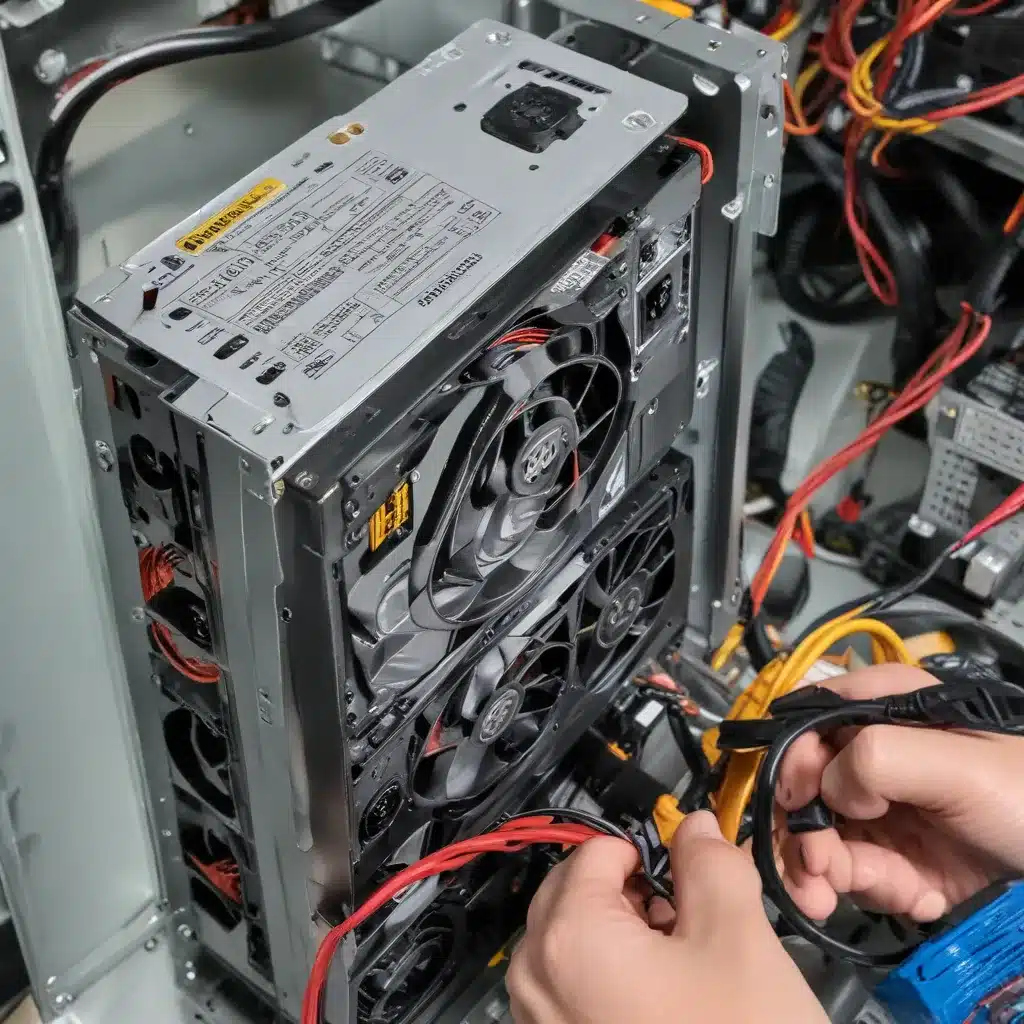
Power Supply Unit (PSU)
PSU Basics
The power supply unit (PSU) is the backbone of any desktop computer, responsible for providing the necessary power to all the internal components. It converts the alternating current (AC) from the wall outlet into the various direct current (DC) voltages required by the motherboard, processor, memory, storage drives, and other peripherals.
There are two main types of power supplies commonly found in desktop PCs – the traditional ATX (Advanced Technology Extended) power supply and the more compact SFX (Small Form Factor) power supply. ATX PSUs are the standard in most full-size and mid-tower desktop cases, while SFX PSUs are designed for smaller form factor systems like mini-ITX and slim desktops.
PSU Failure Diagnosis
When a PSU starts to fail, it can manifest in various ways, such as:
- Sudden computer shutdowns: The system may abruptly power off without warning, even when under light load.
- System instability and crashes: The computer may freeze, reboot unexpectedly, or exhibit performance issues.
- Flickering or pulsing power light: The power LED on the front of the case may blink or cycle on and off.
- Failure to power on: The system may not respond at all when the power button is pressed.
To diagnose a potential PSU issue, you can use a digital multimeter to test the output voltages. Disconnect the PSU from the motherboard and other components, then turn it on using a paper clip jumper. Check the +3.3V, +5V, and +12V rails to ensure they are within the expected tolerances, typically within 5% of the rated values.
Desktop Computer Components
Motherboard
The motherboard is the central hub that connects all the components in a desktop computer. It has several power connectors that receive power from the PSU, including the 24-pin ATX main power connector and the 4/8-pin CPU power connector.
Ensure that the motherboard is compatible with the replacement PSU you plan to install. Check the motherboard’s documentation or the manufacturer’s website for the recommended PSU specifications, such as the required wattage, connector types, and form factor.
Central Processing Unit (CPU)
The CPU is one of the components that requires a significant amount of power from the PSU. Overheating can be a common issue that leads to system crashes or unexpected shutdowns. Make sure the CPU’s cooling solution is functioning properly and that the system has adequate airflow to prevent thermal throttling or damage.
PSU Troubleshooting
Identifying PSU Issues
If you’re experiencing sudden computer shutdowns or system instability, it’s important to first rule out other potential causes, such as overheating or hardware conflicts. However, if the issues persist even after troubleshooting other components, the PSU is likely the culprit.
One telltale sign of a failing PSU is the system’s power light rapidly blinking or cycling on and off. This indicates that the power supply is not able to maintain a stable voltage, leading to the system repeatedly attempting to power on and then shutting down.
PSU Replacement Procedure
When it’s time to replace a faulty PSU, ensure that the new unit is compatible with your system. Match the form factor (ATX or SFX), wattage rating, and connector types to the requirements of your motherboard and other components. Consult the manufacturer’s specifications or use an online PSU compatibility checker to ensure a seamless installation.
To replace the PSU, first power down the system and unplug the power cord from the wall outlet. Disconnect all the power cables from the motherboard, drives, and other components. Remove the old PSU from the case, taking note of its orientation and mounting points. Install the new PSU, making sure it is securely fastened, and reconnect all the power cables, taking care to match the correct connectors to their respective components.
PSU Repair Techniques
PSU Component Inspection
If the PSU is not powering on at all, you can try to inspect the internal components for any obvious issues. Carefully open the PSU case and visually inspect the capacitors, fuses, and other components for any signs of damage or discoloration.
Capacitor Replacement: Faulty or leaking capacitors are a common cause of PSU failure. If you identify any suspect capacitors, you can attempt to replace them with new, high-quality components. Be extremely cautious when working with the PSU’s internal circuits, as they can hold a dangerous charge even when the unit is unplugged.
Fuse Replacement: The PSU may also have one or more fuses that can blow due to overloading or other issues. Carefully remove and test the fuses, replacing them with compatible replacements if necessary.
Advanced PSU Repair
For more complex PSU issues, you may need to delve deeper into the repair process. This could involve testing and replacing individual components on the printed circuit board (PCB), such as diodes, resistors, or transistors. However, this level of repair requires advanced electrical and soldering skills, as well as access to specialized testing equipment.
If you’re not comfortable performing intricate PSU repairs, it’s generally recommended to replace the entire unit with a new, high-quality power supply. The cost of replacement is often more economical than attempting complex repairs, especially for older or lower-end power supplies.
Remember, when working on any desktop computer components, always take appropriate safety precautions, such as using an anti-static mat, grounding yourself, and unplugging the system from power before beginning any repairs.
By understanding the role of the power supply, diagnosing common issues, and following proper replacement or repair procedures, you can effectively troubleshoot and resolve PSU-related problems in your desktop computers. If you’re ever unsure or encounter a complex issue, it’s always best to consult with a professional IT technician or visit your local computer repair shop.












